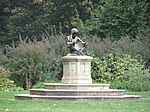Oldfields

Oldfields, also known as Lilly House and Gardens, is a 26-acre (11 ha) historic estate and house museum at Newfields in Indianapolis, Indiana, United States. The estate, an example of the American country house movement of the late nineteenth and early twentieth centuries, was designated a U.S. National Historic Landmark in 2003.Oldfields was built between 1909 and 1913 by architect Lewis Ketcham Davis for the family of Hugh McKennan Landon, who occupied the home from 1913 until 1932 when it was sold to Josiah K. Lilly Jr. Lilly, the late Indianapolis businessman, collector, and philanthropist, renovated and expanded the estate throughout the 1930s and 1940s, updating interiors as well as adding a number of new buildings to the grounds.Now known as Lilly House, the 22-room mansion has undergone historic restoration and is now open to the public. The historic house is currently interpreted to reflect the 1930s era when the Lilly family occupied the residence. The rest of the Oldfields estate, which was given to the Art Association of Indianapolis by Lilly's children in 1967, now makes up a major portion of the Newfields campus. In addition to the home's significance as a representation of the American country house movement, Oldfields' gardens and grounds are a rare example of a preserved estate landscape designed by Percival Gallagher of the Olmsted Brothers firm.
Excerpt from the Wikipedia article Oldfields (License: CC BY-SA 3.0, Authors, Images).Oldfields
Central Canal Towpath, Indianapolis
Geographical coordinates (GPS) Address Website External links Nearby Places Show on map
Geographical coordinates (GPS)
| Latitude | Longitude |
|---|---|
| N 39.828333333333 ° | E -86.185416666667 ° |
Address
Lilly House
Central Canal Towpath
46208 Indianapolis
Indiana, United States
Open on Google Maps





